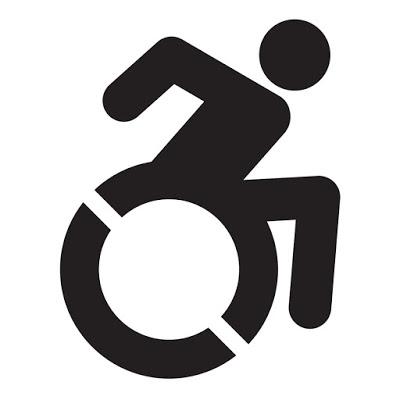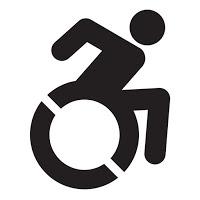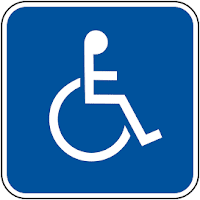
http://www.brianglenney.com/accessible-icon-project
My current project is to review a collection of essays about people with disability. I selected it off of a list of available books thinking, “disability is now part of my experience.” During my time of “disability” I would not have wished the experience on anybody- the unmet needs, isolation, frustration with the system….it was all just hard. Not hard but excruciating. But now that it is over and I am back to my old athletic self, I think everybody should spend some time simulating the experience. It changed my opinions on “accommodations” and how I view people with disabilities. Disability can happen to anybody at any time- it might be temporary (like mine) or it might be permanent. Whichever it is, it is debilitating, humiliating and beyond humbling.
I broke my foot. Not just at any time in life. I broke my foot during a time in life with two small babies (a baby and a 2.5 year old to be exact). Trying to load and unload my car, enter buildings with (or even without) my stroller, and just trying to do everyday things like get dressed, use the restroom and care for my children became unmanageable tasks. My husband was downtown working during the day most of the time and although he was wonderful when he was home, he was not able to help when we were doing our daily routine. The other thing about my broken foot was that it was a minuscule bone on the top of my right foot-not important enough to warrant crutches or an official “disability” parking placard. (But without a proper healing the injury would turn into something much, much worse.) It was just a nuisance of putting a boot on to walk and then changing back into my shoe to drive my car. But- this didn’t mean I could load and unload a 25-pound stroller from my trunk or get my baby/toddler out of the car seat.
So I was excluded- from play dates, from other social opportunities, and almost from the daily preschool routine. With my boot on/off routine, a baby in a car seat (who was not walking) and a 3-year-old with no sense of self, it took me an hour to load and unload my car. And for what? To drop by 3-year-old off at preschool. Only to return three hours later and do it again. All while breastfeeding a young baby and trying to care for her.
Here is what saved me being institutionalized as “crazy.” Disability parking without a disability placard.
Our preschool installed a parking lot near the only entrance for women in exactly my condition. There were about twenty available spaces where you could park up against a perfect paved curb and enter the building about ten feet away. The other lot had a parking lot with two long hallways and an elevator to navigate. I chose the twenty spots near the door. It also helped that the director noticed my condition and sent a designated parking attendant out to my car every day to do a special drop off/pickup service. I wasn’t even getting out of my car for drop off and pickup. Did I have to ask for this? No, they volunteered. That preschool has a reputation for accommodating situations like this- I was only vaguely familiar with this when we registered. Little did I know that it would save my sanity.


So back to the wheelchair/disability symbol. While my parking lot did not have these placards, the spots were understood to be for people with impediments- many small children, being pregnant and not wanting to walk far, or people in my condition with an injury. The lot’s purpose was obvious in an environment with young families. But -most of the time such a lot needs to be marked- with a recognizable sign.
Which brings me to the accessibility symbol- Brian Glenney and his team updated this back in 2011 to depict the wheelchair occupant as active, not passively sitting in a chair. This is so much more representative of what it means- and so much more respectful of the people using it. Young families with children are very active, young and formerly active people who are injured…. even people permanently disabled are active in ways we can’t imagine because we haven’t experienced what they do. All of these scenarios fit within the purpose of this placard.
Let’s use the updated placard with pride- legalize it and formalize its use. Disability/accessibility accommodations are not for passive participants - we are active and involved citizens. I can say “we” because I was one of them.
